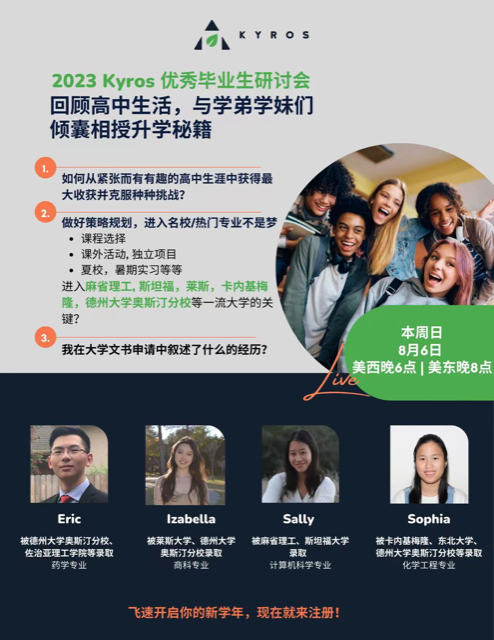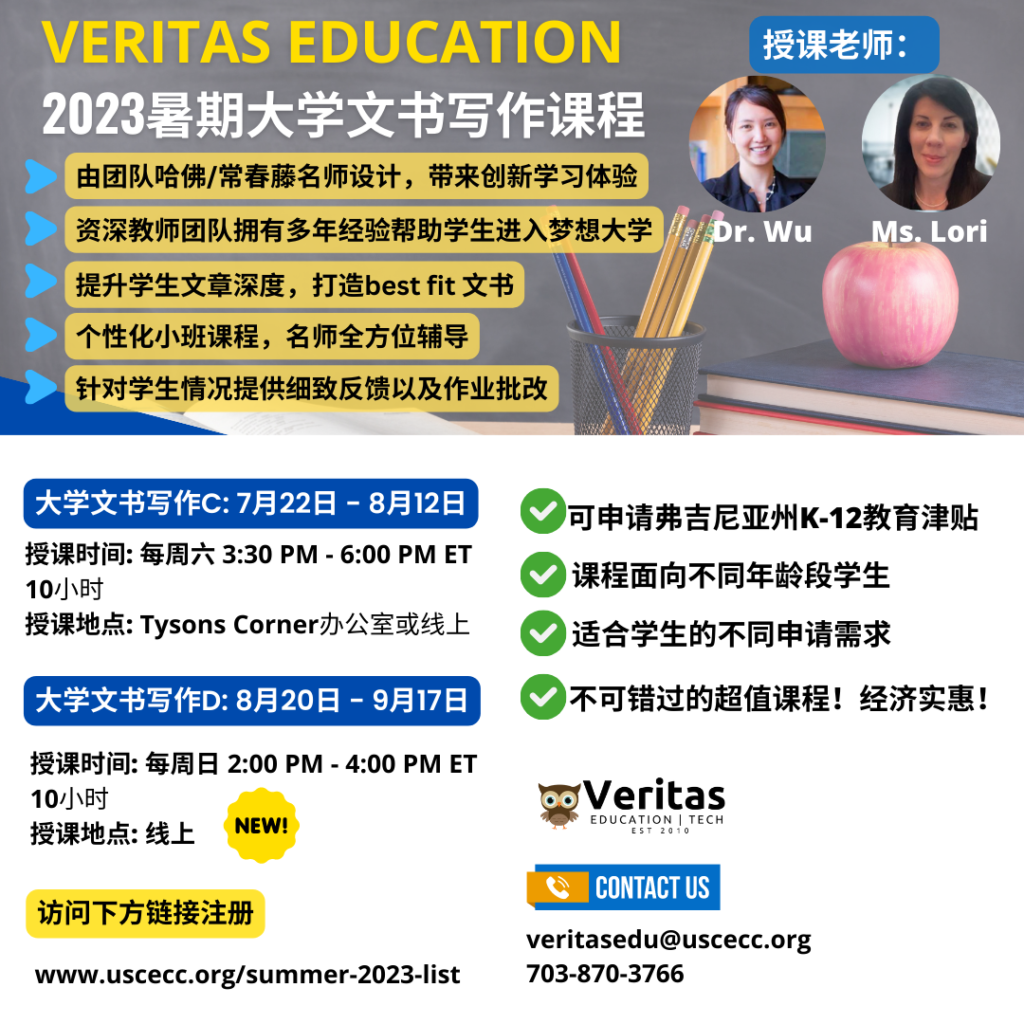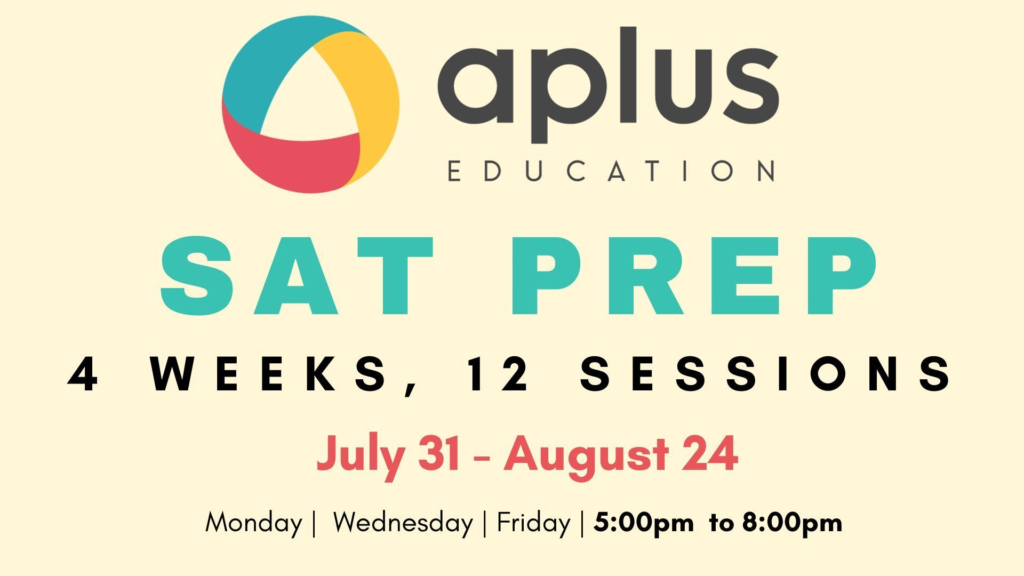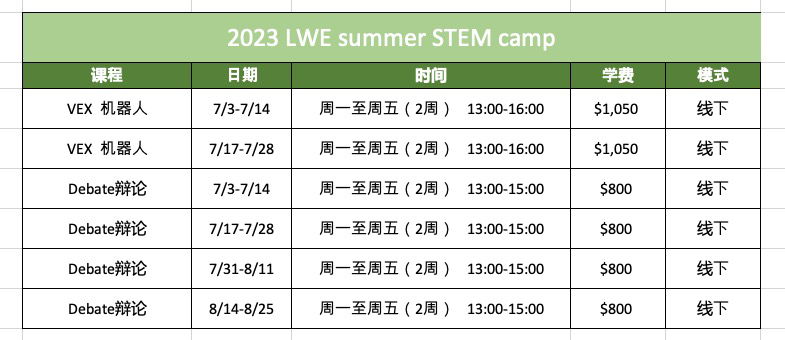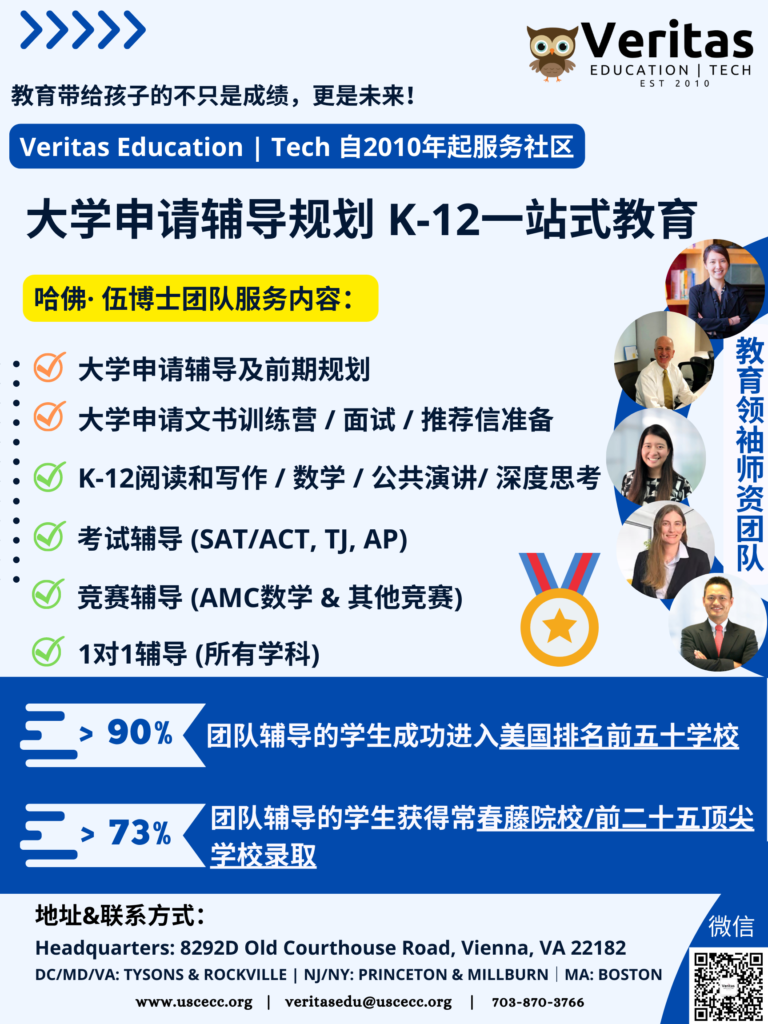美国科技人才为什么被加拿大“挖墙脚”?
彭博社
8/04/2023
美国彭博社8月1日社论,原题:不要责怪加拿大掠夺美国科技人才
美国的繁荣取决于其对外国人才的吸引力。但现在由于移民制度的缺陷,数百万人在美获得永久居留权方面正在面临难以逾越的障碍,而导致其他国家趁机抢夺人才。这一切正在发生:在这场人才争夺战中,美国的竞争对手竟然是加拿大。
上个月,加拿大政府专门为在美外籍人员推出了一个新的工作许可证。持有H-1B签证的在美外籍人员可以申请为期3年的工作许可证,申请成功后可在加拿大任何机构工作。而且与美国不同的是,其配偶也可以在加拿大自由选择就业机会。
加拿大政府宣布,将在该政策实施的首年接收1万名来自美国的H-1B签证持有者。但该申请开放不到48小时,申请人数就已经过万,甚至还有加拿大的科技公司提出要求,希望政府将指标增加1倍。
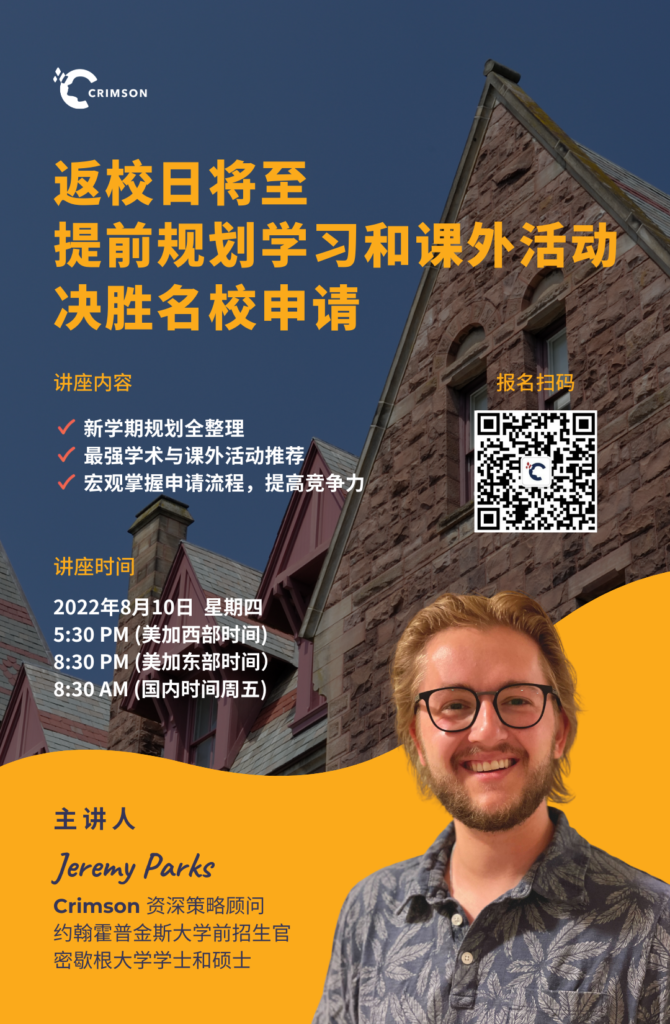
加拿大对高科技人才“挖墙脚”的行为应给美国敲响警钟。美国曾是全球理工科人才的聚集地,如今每年有数万名人才流失到加拿大。
美国将为自己的失败政策付出代价。H-1B签证持有者每年向联邦政府和州政府缴纳至少850亿美元个人所得税,创造数百亿美元消费。他们不但没有抢了本地人的“饭碗”,反而带动了企业投资扩张,而不是将工作机会转移到国外。如果科学家和工程师不断离开美国,相对应的企业也会跟着离开,而这会造成美国的生产力下滑、经济增长减速,生活水平降低。
拜登总统应该呼吁国会接纳更多企业需要的移民人才,并让他们能够更容易地获得永久居留权。在这方面,加拿大实际上给了美国一个教训。而我们希望美国能够引起重视。

罕见!美国H-1B签证安排再次抽签 恐因大量假申请被拒绝
星岛日报
7/28/2023
公民及移民服务局(USCIS)宣布,将会就下个财年的H-1B签证举行第2轮抽签,有移民专家相信,当局可能拒绝了大量可疑个案,留下不少名额,因此才有新的安排。
综合USCIS官方公告及《印度时报》报道,当局在27日发表声明,表示稍后将再次以抽签方式,选出今年10月至明年9月可在美工作的专才,但范围仍会集中在早前收到的电子申请个案。
考虑到官方今年3月已举行首轮抽签,多名移民专家回应时表示,不排除有些企业为了争抢名额,串通某些机构重复申请,借此增加自己的成功几率,而移民局可能发现这类个案后,拒绝了大量“欺诈”申请,另行设法填补名额。
回顾以往,移民局在2021年7月也曾进行2轮抽签,但当年的理由在于企业提交的申请较少,到了2023年财年,当局只需1轮抽签便完成分配。
在不同国籍的专才中,来自印度的申请人是主要受惠对象,得到科技企业担保的人尤其具有优势,一般都能在第2轮抽签中选。
根据《H-1B特殊职业工作者特征》(2022)报告,印度申请人在2022财年拿下7.7万余个H-1B名额,占总数大约59%;中国申请人则获得大约1.9万个名额,在所有国家中排名第2。
移民专家认为,次轮抽签对已身在美国、特别是等待转换H-1B签证的学生来说特别有用,毕竟他们已完成学业,若要合法在美工作便需借助这类资格。
联邦政府每年为H-1B签证预留8.5万个名额,当中2万个会分配给在美高校取得高等学位的申请人,这种签证允许外国公民短期在美工作,但性质不属于移民签证。移民局曾表示,关注部分企业和申请人滥用H-1B计划的问题,因此会积极调查,并采取相应的打击措施。
美送大礼 印度劳工持H-1B签证可在美境内申请延签
世界新闻网
6/23/2023

国务院即将宣布,持H-1B工作签证入境美国的少数印度劳工与其他国家劳工,今后将可在美国境内申请延签,不用出境办理。图为印度侨民22日聚集白宫南草坪欢迎印度总理莫迪到访。(路透)
印度总理莫迪(Narendra Modi)抵达美国展开国事访问,拜登政府送上大礼,让印度高技术印度劳工今后进出美国、在美居留都将变得更为便利。拜登总统希望让美国、印度这两个全球人口最多的民主国家更紧密结盟,提高面对中国的竞争力。
知情人士表示,国务院将宣布,持H-1B工作签证入境美国的少数印度劳工与其他国家劳工,今后将可在美国境内申请延签,不再像以前必须出境办理。这项试办计划未来几年可能扩大实施。
据统计,H-1B签证计划里人数最多的是印度公民,2022会计年度全美44万2000名H-1B签证劳工中,高达73%是印度人。
一名美国官员说,人力流动是重要资产,美国希望通过多面向管道达成目标,国务院非常努力寻找各种具有创意的改革方式。
彭博法律(Bloomberg Law)今年2月就披露了H-1B工作签证试办计划。国务院发言人说,试办计划将从少数案例开始,未来一、两年逐渐放宽名额。
不过,试办计划公布之前,程序步骤仍可能改变,相关细节也尚未定案。
美国政府每年开放6万5000个H-1B签证名额供企业申请,以便引进高技术外国劳工,另外还有2万个签证名额则提供给拥有高等学历的外国劳工。H-1B签证效期三年,到期之后可以延签三年。
最近几年使用最多H-1B劳工的企业,包括印度软件巨擘印福思(Infosys)、印度顾问公司塔塔咨询服务(Tata Consultancy Services)、亚马逊(Amazon)、谷歌(Google)母公司Alphabet、脸书(Facebook)母公司Meta。
消息人士说,试办计划对象也包括L-1签证持有人。L-1签证是发给被公司调到美国工作的外国经理。
另一方面,美国驻印度使领馆长期以来签证处理积案严重,如今终于出现改善迹象。知情人士说,美国官员本周将在华府与印度访问团代表商讨解决之道。
路透独家:部分H-1B持有者续签 无需离美
世界新闻网
6/22/2023

路透报导,国务院将利用印度总理莫迪本周访美期间,宣布部分持有H-1B工作签证的外国人,续签时可以留在美国。(Getty Images)
路透独家报导,三名知情人士表示,国务院将利用印度总理莫迪本周访美期间,宣布部分持有H-1B工作签证的外国人续签时可以留在美国。
美国去年总共有44万2000人持有H1-B签证,其中73%是印度人。
一名国务院发言人拒绝对于哪些签证类型符合资格或何时开始试行发表评论,但表示:「试行计划会从少量案例开始,目的在接下来一到两年内扩大该计划的规模。」
白宫拒绝发表评论。
一名消息人士称,这项先行计划还将包括一些持有L-1签证的外国人。
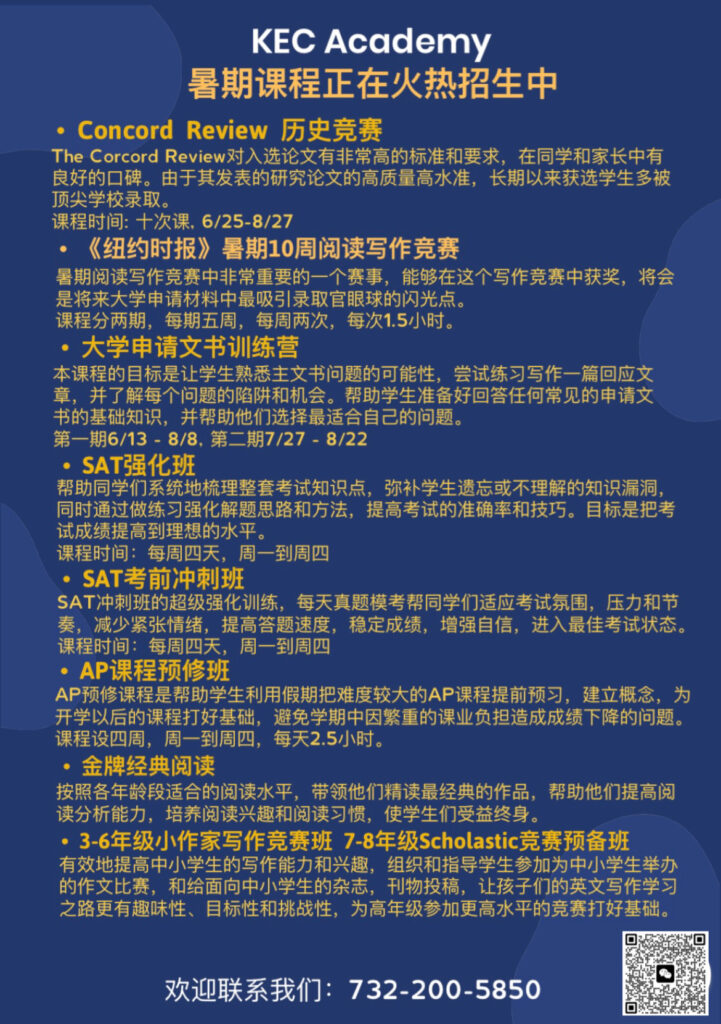
莫迪访美国 美料放宽印度技术工人签证
6/22/2023

印度长期以来一直关注科技等行业的工人难以获得在美国居住的签证。照片为位于印度班加罗尔的西门子医疗公司的工作人员。(彭博社)
据知情人士说,美国拜登政府将趁印度总理莫迪本周进行国事访问期间,让一些技术工人进入或留在美国,这将使得印度人在美国生活和工作变得更容易。
路透社引述一名消息人士称,国务院最早可能在星期四(6月22日)宣布,少数持有H-1B签证的印度人和其他外国工人将能够在美国续签这些签证,不必离境。试点计划可能在未来几年扩大。
印度公民是迄今为止H-1B计划中数目最多的人,占2022财年近44万2000名H-1B工人的73%。
另一名美国官员说:“我们都认识到,人民的流动性对我们来说是一笔巨大的财富……所以,我们的目标是从多方面解决这个问题。”
美国国务院发言人拒绝谈论哪些签证类型符合资格以及试点计划启动的时间。彭博法律公司 (Bloomberg Law) 在2月份首次报道了这个试点计划。白宫拒绝发表评论。
美国政府每年向寻求外国熟练工人的公司发放6万5000个H-1B 签证,并为拥有高级学位的工人额外发放2万个签证。签证有效期为三年,并可续签三年。
美国政府数据显示,近年来使用H-1B员工最多的公司包括印度科技巨头印孚瑟斯公司(Infosys)和塔塔咨询服务公司(Tata Consultancy Services ),还有就是美国的亚马逊、Alphabet和Meta。
国务院发言人指出,一些临时外国工人能够在美国续签签证,这将为驻外领事馆的签证面试腾出资源。
其中一名消息人士称,该试点计划还将包括一些持有L-1签证的工人,这些签证适用于由公司内部调往美国的人员。
另一名消息人士称,两国代表团预料也将讨论如何清理美国驻印度大使馆积压的签证申请。印度长期以来一直担心其公民(包括科技行业工人)难以获得在美国居住的签证。
据劳工部数据,截至4月底,美国约有1000万个职位空缺。
美国的一些H-1B签证持有者包括今年解雇的数千名科技工人,他们争先恐后地在60天的“宽限期”内寻找新雇主,免得返回祖国。
大快人心!美国开始处理虚假H-1B抽签 有人终生拒签!
一亩三分地
5/14/2023
4月28日,我们推文:H1B抽签破78万人!移民局终于动手查了!文中提到,美国政府开始调查有欺诈行为的签证申请人的资格。
今天有用户在reddit上看到信息以后在论坛发帖:USCIS开始处理违法多抽的H1B了!拒签+lifetime ban:

楼主表示,有一个在世界五百强工作的印度员工,申请了多个H1B抽签。
此人有fortunate 500 company的offer,这个offer当然是真实的。其他的都是虚假offer,来自抽签服务的皮包公司。
上周在印度的Delhi,他被询问他与其中一间的关系,显然是被调查怀疑上了。最后,他被终生禁止进入美国。
并且,他去年参加抽签,不是今年,可见,美国政府的调查会回溯往年。
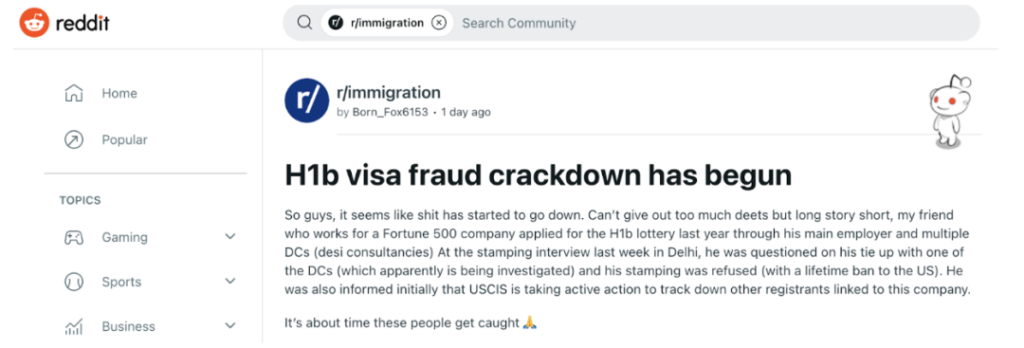
目前看来有些提供虚假抽签服务的皮包公司被盯上了,美国政府已经展开行动了,在数据库里很容易查出完整名单。
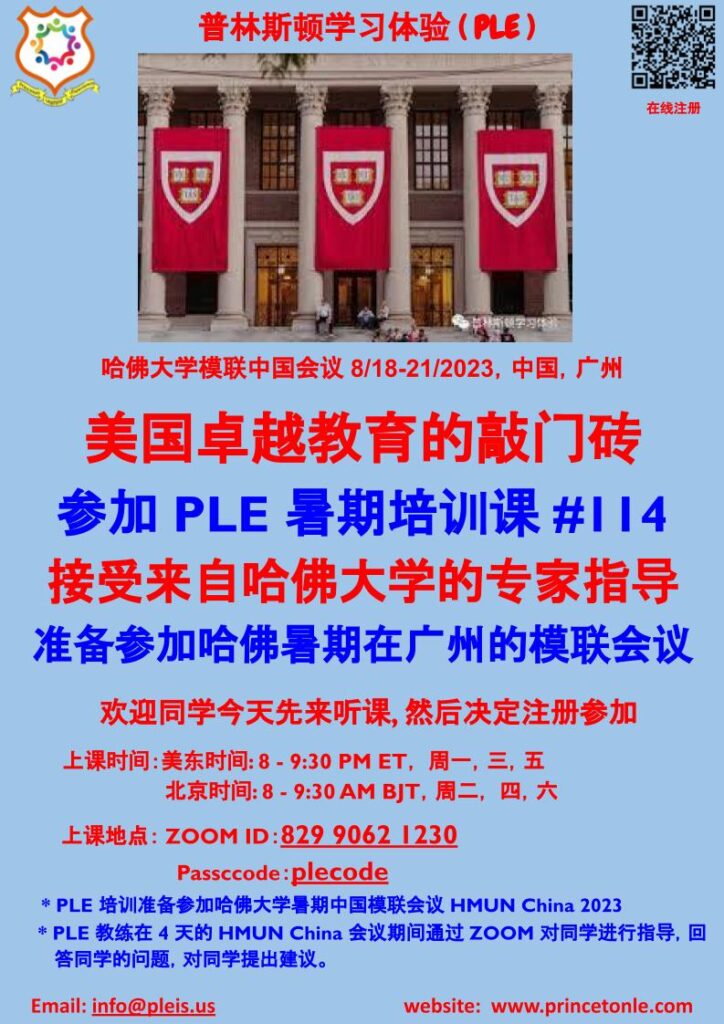
相信跟这些皮包公司有勾结的,不管是今年还是往年参与的,一个都跑不掉,都会被查。
具体有哪些公司上名单?移民局公告里说保密。
reddit帖子有回复写到:
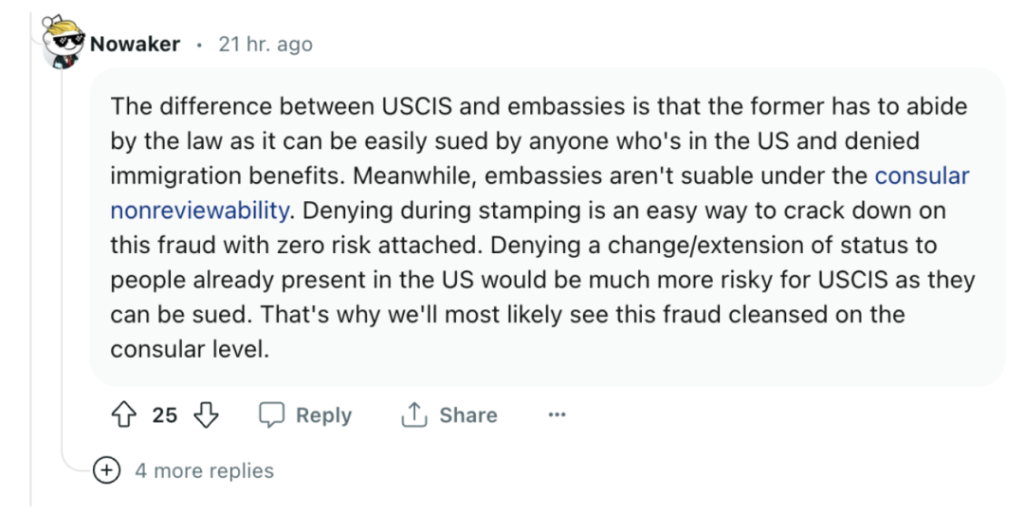
如果在美国境内通过USCIS打击虚假抽签,那被起诉的人有权进行法律辩护,对USCIS来说,多少都有些麻烦,但是通过大使馆拒签,则非常容易,外国人没有进入美国的权利,被拒了也没法上诉。
跟当年findream涉案者一样,美国政府重罚!这个例子里的涉案人被终生禁入美国,即使他有一个真实的、fortune 500大公司的job offer。
美国境内是否也会追查?相信也会的。美国政府不会只通过大使馆拒签这一招来对付签证欺诈。
我们会持续追踪事态的进展,希望有关部门的大力调查,能还H1B抽签一个公平和真实的环境。
H-1B抽签滥用愈演愈烈 10万人递交40万次申请
星岛日报
4/29/2023

拜登政府表示,当局发现数十家小型科技公司为增加外籍雇员H-1B 签证中签机会,串通一气为同一申请人多次提出申请。
《华尔街日报》报道,负责发放H-1B签证的美国公民及移民服务局(USCIS),28日向相关雇主发出通知,告知上述发现。USCIS称,这种做法在很大程度上导致今年H-1B签证需求达到历史新高,共有78万1000人参加抽签,争抢8.5万个名额。导致参加抽签人数大增,主要归因于由少数公司重复提出申请,大约有9.6万人共提交了40.8万次申请。
虽然从技术角度来看,外籍雇员通过多家公司申请H-1B签证并不违法,但申请的公司必须证明,如果该雇员获得签证,他们须提供真正工作。如果获得签证的公司随后迅速将员工外包给第三方,或者解雇获得签证的员工以便对方更换公司,将可能构成欺诈。
政府以调查正在进行为由,拒绝透露有关公司名称。一些知情者透露,它们是IT界名不见经传的小公司,其中一些公司成立的目的,可能就是为了重复提交H-1B申请。
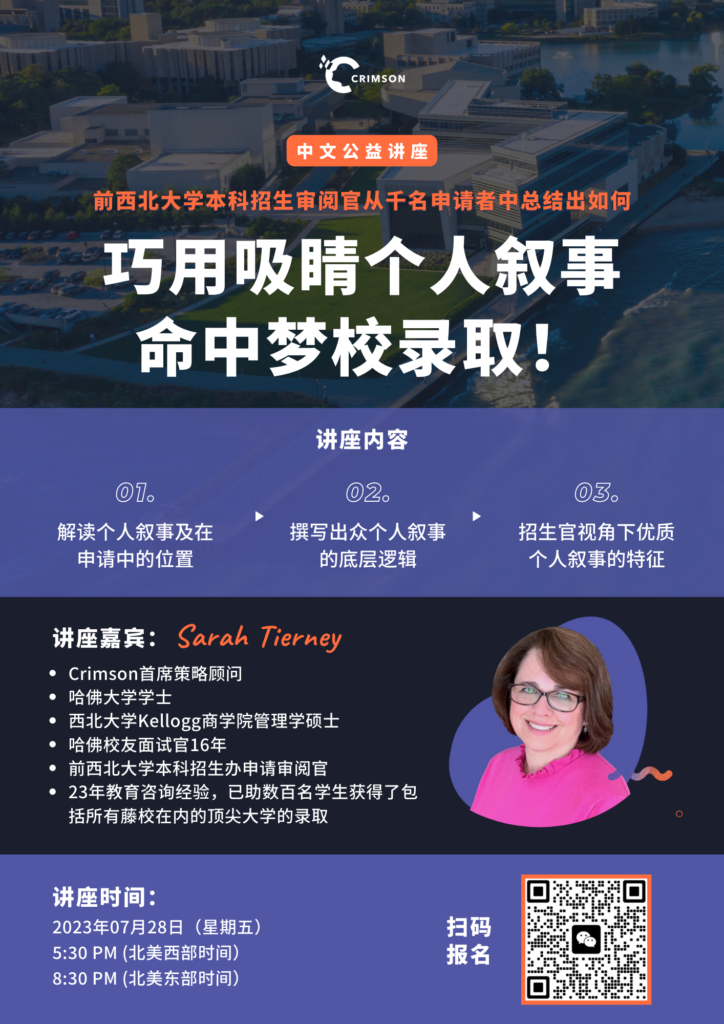
USCIS官员称,这些公司已将这一情况转介给联邦执法机构,涉事的公司可能面临潜在的刑事起诉。官员表示,政府上月底抽签可能抽中一些重复申请者,但如果他们是为了增加中签机会而进行欺诈,那 其资格可能会被取消。这位官员还说,如果有足够多申请被取消,政府可能会进行二次抽签。
自1990年推出以来,H-1B签证一直是美国企业雇用主要在美国获得大学学位外籍员工的重要途径,也是国际学生通过雇主获得永久居民和公民身份的方式。近年来对该签证的需求远远超过年度配额。
分析指,滥用H-1B签证制度始于特朗普政府对该项目做出更改之后。在2020年前,公司需提交大量支持材料并支付数千元以证明它们所提供的职位和员工资格后才可参加抽签,而从2020年开始,潜在的H-1B申请人只需将名字在新系统注册并支付10元的费用即可。一旦被选中,他们再支付相关费用。更新后的系统旨在减少公司及员工为参加抽签而必须投入的金钱和工作量,但同时大大降低了参加抽签的门槛,并给重复申请提供了可乘之机。为防止欺诈泛滥,政府已提议将注册费用提高到215元,这一变化可能会在明年抽签之前施行。
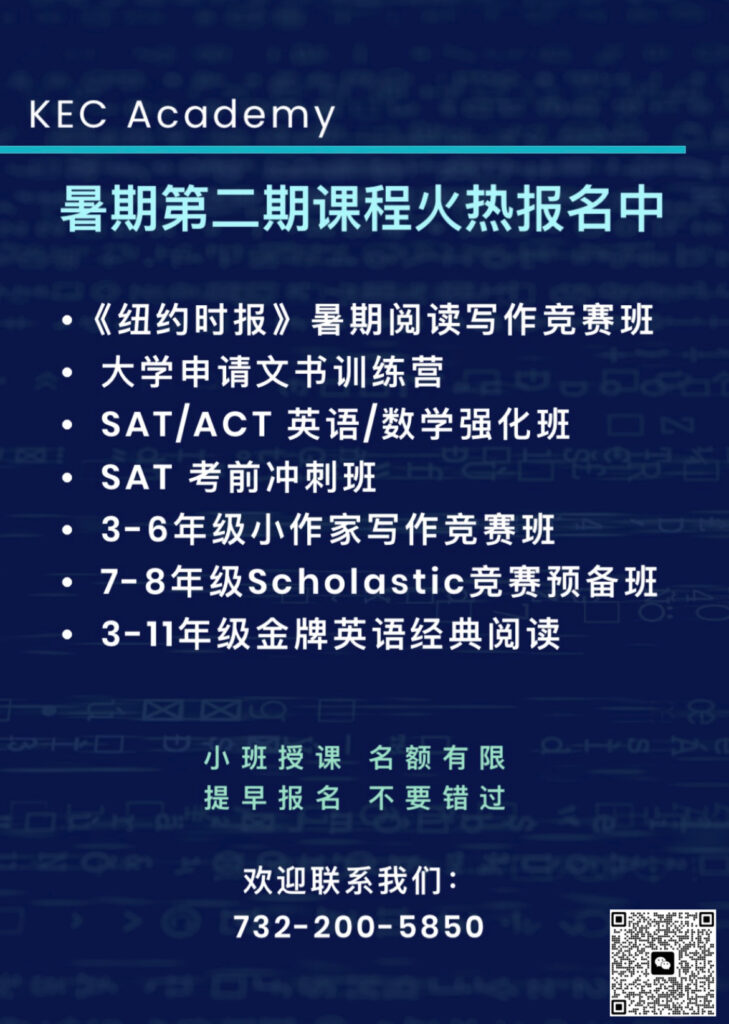
世说新闻╱谁在从中作梗?华人移民难上加难
世界新闻网
4/04/2023

2023年想通过工作的方式留在美国,可谓困难重重。(世说新闻团队制作)
2023年想通过工作的方式留在美国,可谓困难重重。除了许多公司为了应对可能的经济不景气,大规模裁员外,H1B工作签证的中签率,也降至近年来新低。有华人连续四年抽签不中,对前路感到迷茫。移民律师指出,印度人利用规则挤占名额,是工作签证越来越难抽的重要原因。
Apr 4, 2023
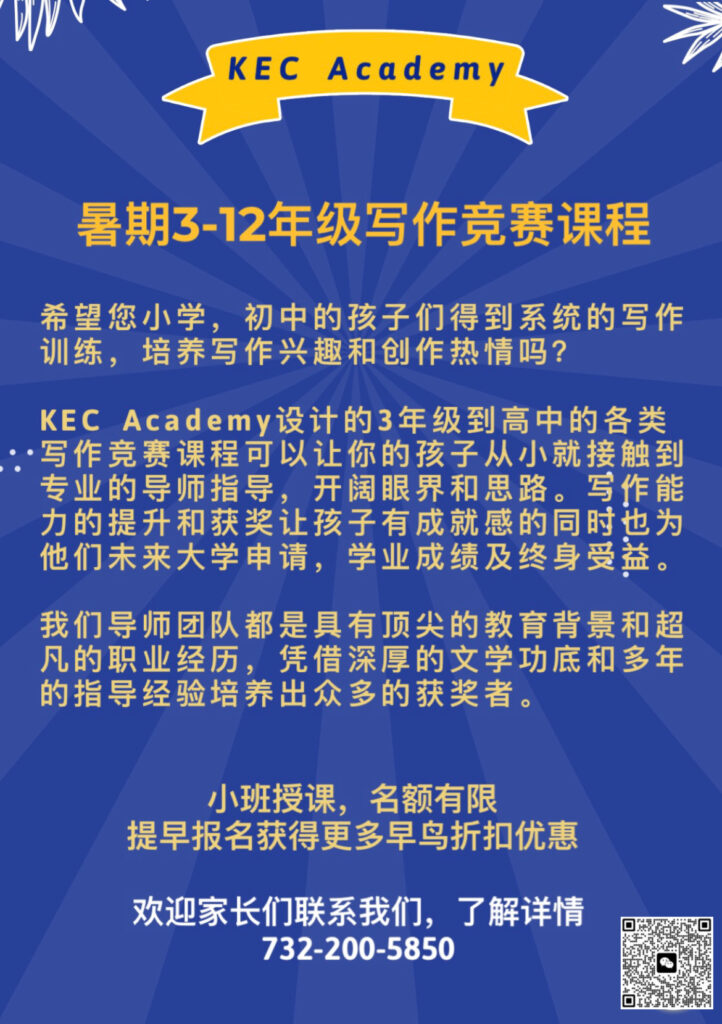
移民局:B1/B2签证可找工作 但上班前须先转换身分
世界新闻网
3/26/2023

美国公民及移民服务局(U.S. Citizenship and Immigration Services,USCIS)在推特发表声明指出,持观光、商务签证入境美国的外籍人士,如今可以在美国找工作或参加面试。
为了澄清与工作证有关的消息混淆,公民及移民服务局在推文中写道,持B-1、B-2以及B-3签证入境美国的外籍人士,如今可以在美国找工作以及参加面试。
不过,公民及移民服务局在推文中强调,持观光、商务签证入境者找到工作之后,必须在开始上班之前,确认签证类别已经转换完成。
公民及移民服务局推文写道:「许多民众都曾询问,身分为B-1或B-2签证期间能不到寻找新工作。答案是可以的。寻找就业机会以及为了就业参加面试,都是持有B-1或B-2签证时受到准许的活动。」
求职期间 须申请更改身分
B-1或B-2签证持有人在美国找工作期间,必须提出更改非移民身分的申请,并且取得特殊状况工作许可。B-1或B-2签证持有人也可以申请更改雇主。
公民及移民服务局说,即使之前持有的非移民签证遭到取消,在美国停留的时间仍然可以超过60天的宽限期,但如果没有在规定时间内完成身分转换,最后可能必须带着家属一同离境。
然而,申请签证身分更改如果遭到拒绝,申请人就必须离开美国,要先转换到另一种签证,才能开始工作。
公民及移民服务局表示,非移民劳工如果丢掉工作,不管是自愿失业或非自愿失业,在符合条件的情况下,如果按照程序提出申请,可以获准继续留在美国,包括提出更改非移民身分申请,或提出调整移民身分申请及申请特殊状况工作许可。
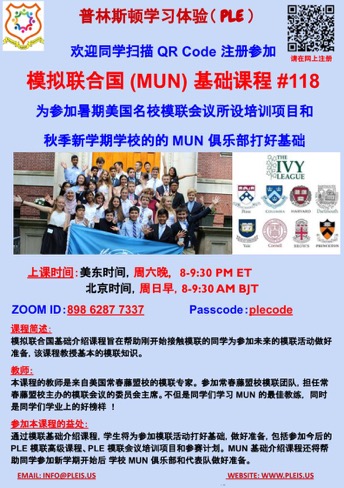
USCIS Provides Guidance on Program for International Entrepreneurs
Release Date: 03/10/2023
U.S. Citizenship and Immigration Services has issued comprehensive guidance (PDF, 311.98 KB) on parole for international entrepreneurs.
To enhance entrepreneurship, innovation and job creation in the United States, the Department of Homeland Security (DHS) published the International Entrepreneur Rule on Jan. 17, 2017.
This rule provides a framework for DHS to use its parole authority to grant a period of authorized stay, on a case-by-case basis, to noncitizen entrepreneurs who possess a substantial ownership interest in a start-up entity and who can demonstrate that their stay in the United States would provide a significant public benefit through that start-up entity’s potential for rapid business growth and job creation.
After fully implementing the International Entrepreneur Rule in 2021, we have received a growing number of applications and continue to adjudicate them as expeditiously as possible.

We are now publishing guidance in the Policy Manual, which includes information about:
- The criteria for consideration for the applicant, the start-up entity, and the qualified investment or government award or grant;
- Evidence and documentation;
- The discretionary nature of the entrepreneur parole adjudication;
- Conditions on parole and bases for termination;
- The criteria for consideration for an additional parole period; and
- Options available to the entrepreneur’s family to join the entrepreneur as parolees and, if eligible, to obtain employment authorization.
Although an individual who is paroled into the United States has not been admitted into the United States for purposes of immigration law, parolees may enter and remain in the United States and may be authorized to work.
For more information, see Part G (International Entrepreneur Parole) in Volume 3, Humanitarian Protection and Parole, of the USCIS Policy Manual.
Additional information on the international entrepreneur parole process, including the criteria for consideration, related definitions, how to apply, and questions and answers, is available on the International Entrepreneur Parole page.
Last Reviewed/Updated: 03/10/2023
USCIS to Start Collecting Fee for EB-5 Integrity Fund
Release Date: 03/01/2023
Today, the Department of Homeland Security posted a Federal Register notice providing information related to the EB-5 Integrity Fund. We will use the EB-5 Integrity Fund primarily to administer the EB-5 Regional Center Program, as required by the EB-5 Reform and Integrity Act of 2022. Starting March 2, we will collect an annual fee from each designated regional center to finance the EB-5 Integrity Fund.
As required under the new EB-5 law, the fee is $20,000 for regional centers with more than 20 investors and $10,000 for those with 20 or fewer investors. The fee payment for fiscal year (FY) 2023 is due by Apr. 1, 2023, and regional centers must pay the fee online directly at Pay.gov, a system managed by the U.S. Department of the Treasury. Starting in FY 2024 (October 2023), the fee will be due at the start of each fiscal year between Oct. 1 and Oct. 31.
In addition, the filing fee for Form I-526E, Immigrant Petition by Regional Center Investor, increased by $1,000 on Oct. 1, 2022, to incorporate the Integrity Fund fees.
We may use fees collected for the EB-5 Integrity Fund to detect and investigate fraud and other immigration crimes.
硅谷 101 — 有趣的前沿科技深度视频
We will not impose late fees for payments that were due in FY 2023. We will start imposing a late fee, beginning October 2023, for any payments made more than 30 days later than the due date. We will announce the amount of the late penalty and the process for collecting in a future publication before we collect it or it is due.
Per the new EB-5 law, we must terminate the designation of any regional center that does not pay the fee within 90 days of the due date. Termination will not be automatic, and we will provide a notice of intent to terminate and the opportunity to prove that the fee was paid in the proper amount within 90 days of the due date before sending a notice of termination.
The EB-5 Regional Center Program makes visas available to qualified immigrants (and the eligible spouses and children of such immigrants) who pool their investments with other qualified immigrants in a “regional center” in the United States. We designate regional centers based on a proposal for the promotion of economic growth, including prospective job creation and increased domestic capital investment in their requested geographic region.
The Federal Register notice and the EB-5 Integrity Fund page explain the requirement for the fee and provide the process for how it is to be paid.
Last Reviewed/Updated: 03/01/2023
第一次买房者可申请到 $12500-$15000 的买房补助,并且首付可放到低至3%.
两个不同的补助项目:
1. 一个是高达 $15000 补助,目前对马里兰州的所有County和滨州的York County开放.
2. 另一个是 $5000 补助,对全美50个州开放.
USCIS Issues Clarifying Guidance for Individuals Authorized to Work Under Special Student Relief Provisions
Release Date: 02/22/2023
U.S. Citizenship and Immigration Services is issuing policy guidance in the USCIS Policy Manual to clarify the validity period of employment authorization for F-1 nonimmigrant students experiencing severe economic hardship due to emergent circumstances (also known as special student relief (SSR)) who are work authorized under the SSR provisions of 8 CFR.
The update clarifies that in cases of severe economic hardship due to emergent circumstances, we may grant off-campus SSR employment authorization to an F-1 nonimmigrant student for the duration of the Federal Register notice validity period. This employment authorization may not extend past the student’s academic program end date. This update notes that we may issue employment authorization documents for the duration of the Federal Register notice, which is typically an 18-month validity period, as permitted by the relevant SSR Federal Register notice.
Emergent circumstances are events that affect F-1 nonimmigrant students from a particular region and create severe economic hardship. These events may include, but are not limited to, natural disasters, financial crises, and military conflicts.
This policy update will be effective when published and will apply to all pending and future applications for SSR employment authorization.
For more information, see the policy update (PDF, 313.07 KB).
Last Reviewed/Updated: 02/22/2023
北美房屋检查 | 华府房屋检查 MD/VA 电话: (240)784-6645
FY 2024 H-1B Cap Initial Registration Period Opens on March 1
Release Date: 01/27/2023
Today, U.S. Citizenship and Immigration Services announced that the initial registration period for the fiscal year 2024 H-1B cap will open at noon Eastern on March 1 and run through noon Eastern on March 17, 2023. During this period, prospective petitioners and representatives will be able to complete and submit their registrations using our online H-1B registration system.
We will assign a confirmation number to each registration submitted for the FY 2024 H-1B cap. This number is used solely to track registrations; you cannot use this number to track your case status in Case Status Online.
Prospective H-1B cap-subject petitioners or their representatives are required to use a myUSCIS online account to register each beneficiary electronically for the selection process and pay the associated $10 H-1B registration fee for each registration submitted on behalf of each beneficiary. Prospective petitioners submitting their own registrations (U.S. employers and U.S. agents, collectively known as “registrants”) will use a “registrant” account. Registrants will be able to create new accounts beginning at noon Eastern on Feb. 21.
Representatives may add clients to their accounts at any time, but both representatives and registrants must wait until March 1 to enter beneficiary information and submit the registration with the $10 fee. Prospective petitioners or their representatives will be able to submit registrations for multiple beneficiaries in a single online session. Through the account, they will be able to prepare, edit, and store draft registrations prior to final payment and submission of each registration.
If we receive enough registrations by March 17, we will randomly select registrations and send selection notifications via users’ myUSCIS online accounts. If we do not receive enough registrations, all registrations that were properly submitted in the initial registration period will be selected. We intend to notify account holders by March 31.
The U.S. Department of Treasury has approved a temporary increase in the daily credit card transaction limit from $24,999.99 to $39,999.99 per day for the FY 2024 H-1B cap season. This temporary increase is in response to the volume of previous H-1B registrations that exceeded the daily credit card limit. Additional information will be provided before the start of the initial H-1B registration period.
An H-1B cap-subject petition, including a petition for a beneficiary who is eligible for the advanced degree exemption, may only be filed by a petitioner whose registration for the beneficiary named in the H-1B petition was selected in the H-1B registration process.
Last Reviewed/Updated: 01/27/2023
USCIS
Recommendations for Paper Filings to Avoid Scanning Delays
Release Date: 12/19/2022
U.S. Citizenship and Immigration Services (USCIS) is providing information for nonimmigrant workers whose employment has terminated, either voluntarily or involuntarily. These workers may have several options for remaining in the United States in a period of authorized stay based on existing rules and regulations.
Below is a compilation of options that may be available to nonimmigrant workers seeking to remain in the United States in a period of authorized stay following termination. Please note that not all options below provide employment authorization.
60-Day Grace Period
Regulations permit a discretionary grace period that allows workers in E-1, E-2, E-3, H-1B,
H-1B1, L-1, O-1, or TN classifications (and their dependents) to be considered as having maintained status following the cessation of employment for up to 60 consecutive calendar days or until the end of the authorized validity period, whichever is shorter (See 8 CFR 214.1(l)(2)).
During this period, workers may be able to maintain their nonimmigrant status if a new employer timely files a petition on their behalf with an extension of stay request (e.g., an H-1B change of employer petition for a worker in H-1B status).
Alternatively, workers may be able to remain in the United States in a period of authorized stay if they timely file an application to change to a new nonimmigrant status (such as B-2 visitor nonimmigrant status) or an application for adjustment of status, if eligible (see below for a detailed overview of options).
Workers who are unable to timely file a change of status application, or find a new employer who timely files a change of employer petition for the worker, may be required to depart the United States at the end of this grace period.

Portability to a New Employer
Portability rules permit workers currently in H-1B status to begin working for a new employer as soon as the employer properly files a new H-1B petition with USCIS, without waiting for the petition to be approved. More information about H-1B portability can be found on our H-1B Specialty Occupations page.
Also, a worker with an adjustment of status application (Form I-485) that has been pending for at least 180 days with an underlying valid immigrant visa petition (Form I-140) has the ability to transfer the underlying immigrant visa petition to a new offer of employment in the same or similar occupational classification with the same or a new employer. This is commonly referred to as “porting.” More information about porting can be found in the USCIS Policy Manual.
Change of Status
Workers may use the up to 60-day discretionary grace period to apply to change their nonimmigrant status, which may include changing status to become the dependent of a spouse (e.g., H-4, L-2). Some individuals in a dependent nonimmigrant status may be eligible for employment authorization incident to status, including spouses of E-1, E-2, E-3, or L-1 nonimmigrants (See USCIS Policy Manual). In addition, some spouses of H-1B workers may be eligible for work employment authorization if certain requirements are met.
Other possible nonimmigrant options include student status (F-1) or visitor status (B-1 or B-2). Note that, by statute, B-1 and B-2 nonimmigrant visitors are specifically precluded from “performing skilled or unskilled labor” in the United States. Certain F-1 students, by regulation, may engage in limited employment. For more information, please see our Change My Nonimmigrant Status page.
Potential pathways for noncitizen STEM professionals can be found on our Options for Noncitizen STEM Professionals to Work in the United States page.

Note: The timely filing of a non-frivolous application to change status will toll, or stop, the accrual of unlawful presence until the application is adjudicated. For example, if an individual files a non-frivolous application to change status before the end of the applicant’s 60-day grace period, they will not accrue unlawful presence while the application remains pending even after the 60-day grace period has elapsed. If the application is ultimately approved, then the individual’s status is changed and is considered to have been in a period of authorized presence the entire time the application was pending. If the application is denied, then the individual starts to accrue unlawful presence the day after the denial decision. Please see our Unlawful Presence and Inadmissibility page for more information.
Change of Status and Employer
Workers may use the up to 60-day discretionary grace period to seek a new employer-sponsored nonimmigrant status in the same or different status. For example, depending on the specific facts presented, an L-1 worker may be eligible for new employment under the TN, E-3, or H-1B1 classifications. The timely filing of a non-frivolous change of status application will prevent the accrual of unlawful presence until the application is adjudicated (see above). Such a filing alone will not, however, confer employment authorization in the new position during the pendency of the application, and will not extend employment authorization if the original classification is no longer valid. Some petitions may be eligible for premium processing for an additional fee.
Adjustment of Status
Some workers may be eligible to file a self-petitioned immigrant visa petition concurrently with an adjustment of status application. Examples of immigrant classifications that are eligible for self-petitioning include EB-1 Extraordinary Ability, EB-2 National Interest Waiver, or EB-5 Immigrant Investors. Workers with a pending adjustment application are generally eligible to remain in the United States and obtain an Employment Authorization Document (EAD).
Period of Authorized Stay – Compelling Circumstances Employment Authorization Document
Workers who are the beneficiary of an approved employment-based immigrant visa petition (Form I-140) may be eligible for a compelling circumstances EAD for up to one year if they:
- do not have an immigrant visa available to them in the Department of State’s Visa Bulletin, and
- face compelling circumstances.
Note: A compelling circumstances EAD is a discretionary stopgap measure intended to assist certain individuals on the path to lawful permanent residence by preventing the need to abruptly leave the United States. Workers who begin working on a compelling circumstances EAD will no longer be maintaining nonimmigrant status but generally will be considered to be in a period of authorized stay and will not accrue unlawful presence in the United States while the EAD is valid. More information about eligibility requirements and the application process can be found on our Employment Authorization in Compelling Circumstances page.
Expedite Criteria
Some circumstances may warrant expedited adjudication, including applications to change status to a dependent status that includes eligibility for employment authorization. For example, an application to change status from H-1B to L-2 may be eligible for expedited adjudication to prevent severe financial loss. See the How to Make an Expedite Request page for additional information.
Departure from the United States
Workers may choose to depart the United States. For H-1B and O workers who chose to depart the United States after involuntary cessation of employment, the reasonable costs of transportation to the worker’s last place of foreign residence must be borne by the H-1B employer or by the O employer and O petitioner, as applicable (See 8 CFR 214.2(h)(4)(iii)(E) and 8 CFR 214.2(o)(16)).
Once abroad, H-1B holders may seek U.S. employment and readmission to the United States for any remaining period of their H-1B status. Those seeking another classification for which they may be eligible can complete the application or petition process abroad and seek readmission to the United States.
The above information is now available on our new Options for Nonimmigrant Workers Following Termination of Employment page.
Last Reviewed/Updated: 12/19/2022


